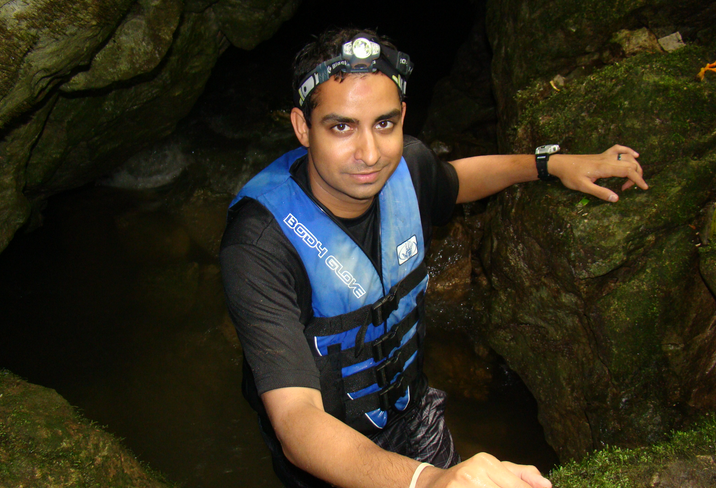(单词翻译:单击)
听力文本
JUDY WOODRUFF: Tonight's Brief But Spectacular features ichthyologist Prosanta Chakrabarty, who studies fish to help explain the evolution of human beings and the planet. He's a professor and curator of fishes at the Museum of Natural Science and Department of Biological Science at Louisiana State University.

PROSANTA CHAKRABARTY, Ichthyologist: Every once in a while, you go to someplace new, where no one has been before, and you see something that is so different that you know it's new right away. It's like, what is this thing? This is so new, I can't believe it. I'm going to go home now and describe this thing before anyone else finds out about it. I grew up loving animals and nature, despite growing up in Queens, New York. And I went as a kid to the Bronx Zoo and the American Museum of Natural History and looked up at dinosaurs and blue whales, and I never looked down. I just wanted to study biology. In the bigger scheme, I'm trying to understand who's related to whom on this planet. One of the things I love to study are freshwater fishes. So, one cave fish is in Australia, and the other one is in Madagascar, which is actually a thing I discovered. Their last connection together wasn't through swimming across the Pacific Ocean, which where they wouldn't be able to survive. Instead, they were last together when those continents were together almost 100 million years ago. The tools that we have available to us are everything from the DNA of the organism to the bodies of the organisms. We can study entire genomes now. And so we can understand things at levels that weren't possible in the past. The things that I have learned about geological history is just how interconnected this planet is. I have learned, you know, going to the Persian Gulf, which is only about 20,000 years old, that this area can tell me about why it rains so much in the Himalayas during monsoon season, or why the connection between North and South America, which is only three million years old, has led to climate change that's changed the dimensions of this planet and the currents. Sometimes, what I'm doing is putting together a puzzle, but I don't have that little box that tells me what the puzzle will be. And so each little piece is a different species on the planet. And the other problem is, many of those species that I need to fill in the puzzle have gone extinct. My name is Prosanta Chakrabarty, and this is my Brief But Spectacular take on life on Earth.
JUDY WOODRUFF: And you can find more episodes of our Brief But Spectacular series on our Web site, PBS.org/NewsHour/Brief.
重点解析
1.available to 获得的
The latest techniques in oceanography are now available to many more scientists.
更多的科学家现在能够接触到海洋学的最新技术。
2.put together 放在一起
He took it apart brick by brick, and put it back together again
他一块砖一块砖地把它拆开,然后又把它组合起来。
3.go extinct 灭绝
The scientists also warned that culling wild birds could make some endangered species go extinct.
这些科学家也警告说,扑杀野生鸟类可能导致一些濒危物种走向灭绝。
4.related to 相关联的
One is also able to see how specific acts are related to a temporal and spatial context
人们也能看出具体行为是如何与时空相关联的。
5.fill in 填充
You will be asked to fill in a form with details of your birth and occupation.
你将需要填写一张有关生日和职业详情的表格。
参考译文
朱迪·伍德拉夫:今晚的《简短而精彩》请到了鱼类学者查克拉巴蒂,他通过研究鱼类来帮助人类解释人类乃至地球的进化过程。他是一名教授,也是自然科学博物馆的馆长,同时还任职于路易斯安那州立大学的生物科学系。
查克拉巴蒂,鱼类学者:有时候,我们会去一些新的地方,那个地方可能从未有人涉足。在那里,你可能会看到与众不同的东西,那一刻,你会立马知道这是一种新的生物。那种感觉就像是:这是什么东西。这是新生物,我真不敢相信。我现在要回家,然后把这个新生物告诉那些能揭开谜题的人。我从小到大都喜欢动物和大自然,虽然我是在纽约皇后区长大的。我小时候曾去过布朗克斯动物园和美国自然历史博物馆,我欣赏过恐龙和蓝鲸,它们的骨架很高大,所以我只能抬头看。我那时候就一心想研究生物学。从更大的图景上看,我试图理解地球上生物彼此之间的关系。有一样东西是我喜欢研究的——淡水鱼。澳大利亚的洞穴鱼以及马达加斯加的另一种鱼类是我发现的。它们两者之间上一次产生联系并不是因为一起游过太平洋,因为它们在那边是不可能活下来的。相反,大概1亿年前,两个大陆相连后,它们才开始在一起。我们现在可以用的工具是有机物的DNA以及尸体。我们现在已经可以研究整个基因组了,所以我们现在理解事物的水平是超乎以往的。关于地质历史,我学到的就是地球上的生物是彼此相连的。我还从波斯湾学到过东西,波斯湾至今已有近2万年的历史了。波斯湾让我学会季风季的喜马拉雅山脉为何雨量如此充沛,以及北美洲和南美洲之间的关系,它们都只有300万年的历史而已,但它们之间的联系却能导致气候变化,继而改变了地球和潮汐的规模。有时候,我所做的事情就是解谜,但我去没有一个小盒子能告诉我谜题是什么。所以,地球上的每个物种都是与众不同的。另一个问题就是:很多我想解开谜题的物种已经灭绝了。我是查克拉巴蒂,这是我本期带来的与地球生命有关的简短而精彩。
朱迪·伍德拉夫:其他期节目可以在官网PBS.org/NewsHour/Brief看到。
译文为可可英语翻译,未经授权请勿转载!


